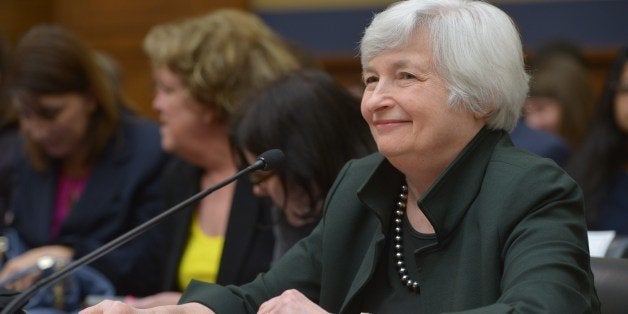
Federal Reserve Board Chair Janet Yellen made waves in her Congressional testimony last week when she argued that social media and biotech stocks were over-valued. She also said that the price of junk bonds was out of line with historic experience. By making these assertions in a highly visible public forum, Yellen was using the power of the Fed's megaphone to stem the growth of incipient bubbles. This is an approach that some of us have advocated for close to twenty years.
Before examining the merits of this approach, it is worth noting the remarkable transformation in the Fed's view on its role in containing bubbles. Just a decade ago, then Fed Chair Alan Greenspan told an adoring audience at the American Economic Association that the best thing the Fed could do with bubbles was to let them run their course and then pick up the pieces after they burst. He argued that the Fed's approach to the stock bubble vindicated this route. Apparently it did not bother him, or most of the people in the audience, that the economy was at the time experiencing its longest period without net job growth since the Great Depression.
The Fed's view on bubbles has evolved enormously. Most top Fed officials now recognize the need to take steps to prevent financial bubbles from growing to the point that their collapse would jeopardize the health of the economy. However there are two very different routes proposed for containing bubbles.
One is to directly use monetary policy to stem the growth of bubbles. There is little doubt that if interest rates are raised high enough they will eventually burst any bubble. If preventing the growth of bubbles is a top Fed priority, then interest rates are one way to accomplish this task.
The interest rate route has a major drawback; high interest rates also slow growth and raise the unemployment rate. As an alternative, many have advocated using the Fed's regulatory powers to try to slow credit flows that are feeding bubbles. Some of us have also advocated talk: the idea that the Fed could provide warnings and information showing that asset prices are getting out of line with fundamentals. This is exactly what Janet Yellen did last week in her congressional testimony.
The logic is not that the Fed chair would just present his or her subjective opinion that some stock or bond prices are too high. Rather, this idea is that they would call attention to solid economic evidence that important asset classes are seriously over-valued. This means carefully documenting the case that the asset prices in question are out of line with the fundamentals in the market, as Yellen did in her written statement to Congress.
While actors in financial markets can ignore an offhand comment about "irrational exuberance" they cannot ignore the evidence put forward by a Fed chair. What would the manager of a hedge fund heavily invested in mortgage backed securities have told investors after they became nearly worthless in 2008 if the Fed chair had documented the case for a housing bubble back in 2003-2006? Did the fund manager have an explanation of why house prices had risen 70 percent above trend levels, even when there had been no increase in rents and there was a record vacancy rate in the housing market? Certainly none did at the time.
By calling attention to the over-valuation of social media and biotech companies, and junk bonds, Yellen is putting the financial professionals on notice. If they don't have a serious answer to the arguments put forward in her statement, these financial professionals may be looking for a new line of work if their bets go south.
It's too early to say whether Yellen's bubble warnings will have the intended effect. The early evidence is positive; the prices for of all three types of assets have fallen. But it will take more time before we can have the full picture.
However the real question should be what is the down side? While some have already derided Yellen as "stock picker in chief," it's clear that she only intends to make these comments in cases where evidence shows asset prices to be seriously out of line with fundamentals. Furthermore past Fed chairs have made comparable judgments in other contexts, for example when Greenspan told Congress that house prices were not excessive back in 2002.
Of course using the Fed's megaphone doesn't preclude also using the regulatory tools at the Fed's disposal. And, in a worst case scenario the Fed should use interest rates to burst a bubble if all else has failed. But hey, talk is cheap.
